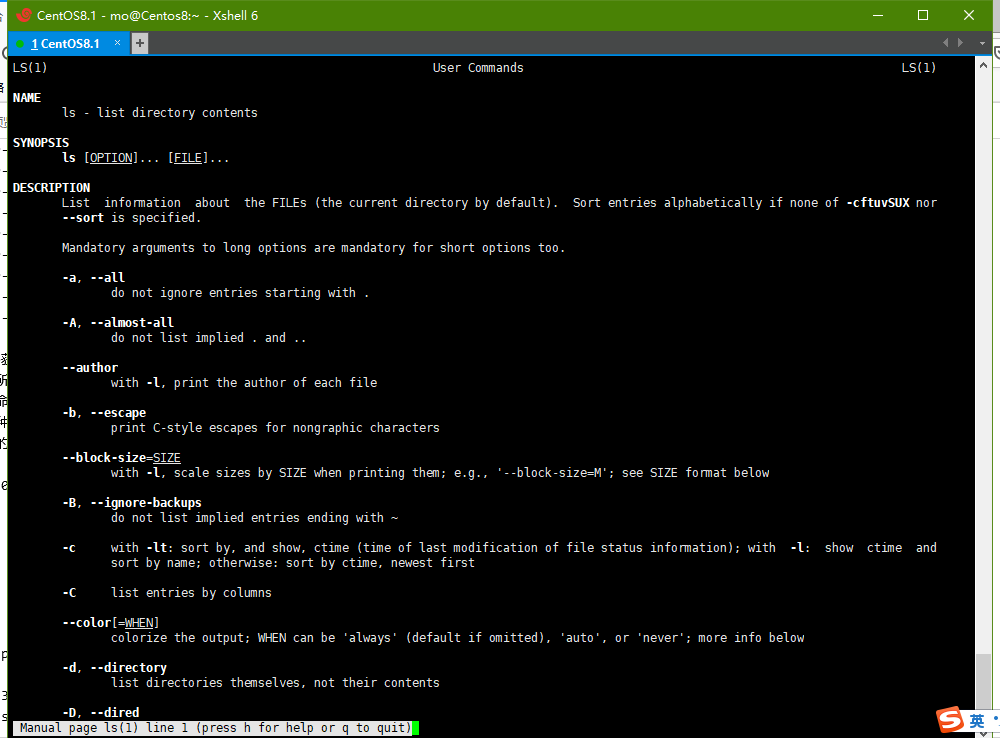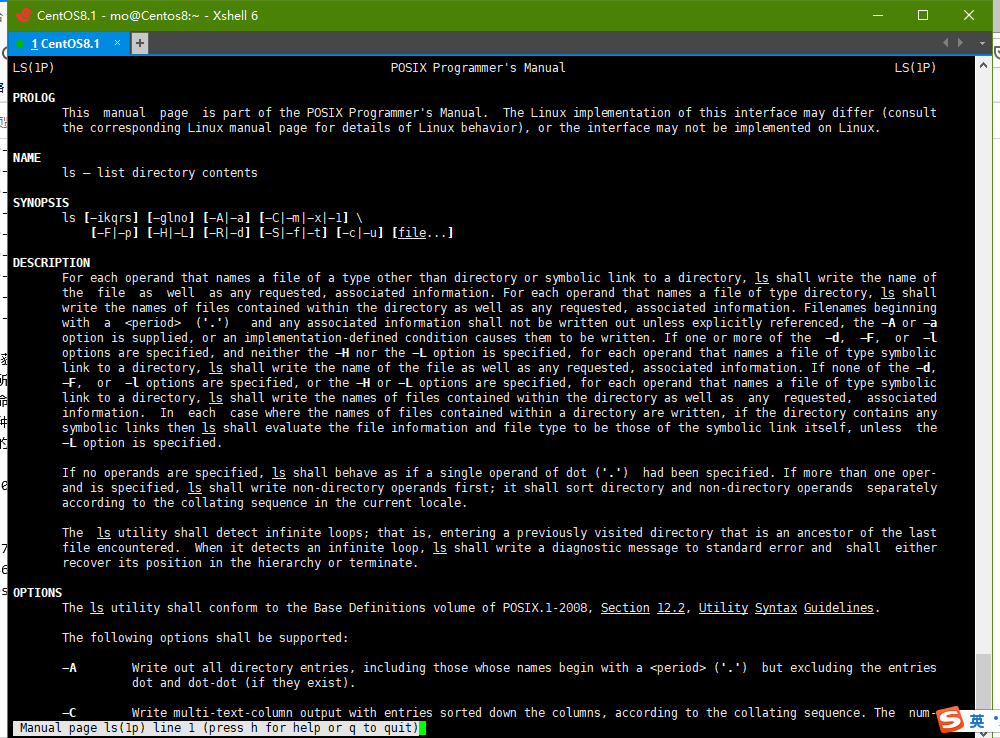linux常用命令格式
Linux命令由 ‘命令+选项+参数’组成
参数是指命令的操作对象,一般文件、目录、用户和进程等可以作为参数被命令操作。
[10:03:40 mo@Centos8\ [ ~]$ls -a ./data
. .. a.txt b.txt lsa.log mima
[10:03:49 mo@Centos8\ [ ~]$
Linux命令的基本格式及ls选项

1.以ls(列出目录)命令为例,直接敲入命令会列出当前目录下的内容
ls 命令后面不加选项和参数也能执行,不过只能执行最基本的功能
[09:37:36 mo@Centos8\ [ ~]$ls
data dead.letter Desktop Documents Downloads mail Music Pictures Public Templates Videos
2.加入参数后可以显示更加丰富的数据
例:
ls -l
-l :长数据串列出,包含文件的属性与权限等等数据
[09:40:14 mo@Centos8\ [ ~]$ls -l
total 12
drwxrwxr-x. 2 mo mo 59 Jan 20 20:24 data
-rw-------. 1 mo mo 4773 Jan 15 10:54 dead.letter
drwxr-xr-x. 2 mo mo 6 Dec 16 16:26 Desktop
drwxr-xr-x. 2 mo mo 6 Dec 16 16:26 Documents
drwxr-xr-x. 2 mo mo 6 Dec 16 16:26 Downloads
-rw-rw-r--. 1 mo mo 32 Jan 12 20:38 mail
drwxr-xr-x. 2 mo mo 6 Dec 16 16:26 Music
drwxr-xr-x. 2 mo mo 6 Dec 16 16:26 Pictures
drwxr-xr-x. 2 mo mo 6 Dec 16 16:26 Public
drwxr-xr-x. 2 mo mo 6 Dec 16 16:26 Templates
drwxr-xr-x. 2 mo mo 6 Dec 16 16:26 Videos
3.选项又分为短格式选项(-a)和长格式选项(--all)。
4.短格式选项是英文的简写,用一个减号调用,长格式选项是英文完整单词,一般用两个减号调用。(是不所有选项都有长格式)
[09:40:20 mo@Centos8\ [ ~]$ls -a
. .bash_logout .cache dead.letter Downloads .ICEauthority mail Music Public .viminfo
.. .bash_profile .config Desktop .esd_auth .local .mailrc Pictures Templates .Xauthority
.bash_history .bashrc data Documents .fontconfig .log .mozilla .pki Videos
[09:42:08 mo@Centos8\ [ ~]$ls --all
. .bash_logout .cache dead.letter Downloads .ICEauthority mail Music Public .viminfo
.. .bash_profile .config Desktop .esd_auth .local .mailrc Pictures Templates .Xauthority
.bash_history .bashrc data Documents .fontconfig .log .mozilla .pki Videos
5.选项可以多个并用
例:
ls -α -l
-a :全部的文件,连同隐藏( 开头为 . 的文件) 一起列出来
-l :长数据串列出,包含文件的属性与权限等等数据
[09:42:57 mo@Centos8\ [ ~]$ls -a -l
total 76
drwx------. 17 mo mo 4096 Jan 26 09:37 .
drwxr-xr-x. 6 root root 58 Jan 20 20:00 ..
-rw-------. 1 mo mo 23702 Jan 25 09:50 .bash_history
-rw-r--r--. 1 mo mo 18 Jul 21 2020 .bash_logout
-rw-r--r--. 1 mo mo 216 Dec 19 08:23 .bash_profile
-rw-r--r--. 1 mo mo 402 Jan 1 21:27 .bashrc
drwx------. 14 mo mo 4096 Dec 16 20:39 .cache
drwx------. 15 mo mo 278 Dec 16 20:40 .config
drwxrwxr-x. 2 mo mo 59 Jan 20 20:24 data
-rw-------. 1 mo mo 4773 Jan 15 10:54 dead.letter
drwxr-xr-x. 2 mo mo 6 Dec 16 16:26 Desktop
drwxr-xr-x. 2 mo mo 6 Dec 16 16:26 Documents
drwxr-xr-x. 2 mo mo 6 Dec 16 16:26 Downloads
-rw-------. 1 mo mo 16 Dec 16 16:26 .esd_auth
drwxr-xr-x. 2 mo mo 79 Dec 16 20:34 .fontconfig
-rw-------. 1 mo mo 4058 Dec 22 12:09 .ICEauthority
drwx------. 3 mo mo 19 Dec 16 16:26 .local
-rw-rw-r--. 1 mo mo 0 Dec 21 14:37 .log
-rw-rw-r--. 1 mo mo 32 Jan 12 20:38 mail
-rw-rw-r--. 1 mo mo 165 Jan 15 09:19 .mailrc
drwxr-xr-x. 6 mo mo 81 Dec 16 20:32 .mozilla
drwxr-xr-x. 2 mo mo 6 Dec 16 16:26 Music
drwxr-xr-x. 2 mo mo 6 Dec 16 16:26 Pictures
drwxrw----. 3 mo mo 19 Dec 16 16:26 .pki
drwxr-xr-x. 2 mo mo 6 Dec 16 16:26 Public
drwxr-xr-x. 2 mo mo 6 Dec 16 16:26 Templates
drwxr-xr-x. 2 mo mo 6 Dec 16 16:26 Videos
-rw-------. 1 mo mo 1042 Dec 28 09:54 .viminfo
-rw-------. 1 mo mo 384 Jan 26 09:37 .Xauthority
6.--help获取当前命令可用选项,
- 并不是所有的帮助信息都是--help,相同作用的选项还有-h(有时候是-h,有时候是--help,部分命令不太相同,--help较多),
- 类似的命令还要info + [选项] 命令,可以查看帮助信息.
- 还有一种就是查看帮助文档,即man命令,相关的命令有 whatis + 命令 可以查看命令的文档位置,在第几章节,使用man + 章节数 + 命令可以查看命令的文档,
- 新安装的命令文档不会立刻加载进man数据库,可以运行 mandb 自行加载进去
[09:58:30 mo@Centos8\ [ ~]$whatis ls
ls (1) - list directory contents
ls (1p) - list directory contents
[09:58:37 mo@Centos8\ [ ~]$man 1 ls
[09:59:46 mo@Centos8\ [ ~]$

[09:59:46 mo@Centos8\ [ ~]$man 1p ls
[10:02:07 mo@Centos8\ [ ~]$

例:
ls --help
[09:44:13 mo@Centos8\ [ ~]$ls --help
Usage: ls [OPTION]... [FILE]...
List information about the FILEs (the current directory by default).
Sort entries alphabetically if none of -cftuvSUX nor --sort is specified.
Mandatory arguments to long options are mandatory for short options too.
-a, --all do not ignore entries starting with .
-A, --almost-all do not list implied . and ..
--author with -l, print the author of each file
-b, --escape print C-style escapes for nongraphic characters
--block-size=SIZE with -l, scale sizes by SIZE when printing them;
e.g., '--block-size=M'; see SIZE format below
-B, --ignore-backups do not list implied entries ending with ~
-c with -lt: sort by, and show, ctime (time of last
modification of file status information);
with -l: show ctime and sort by name;
otherwise: sort by ctime, newest first
-C list entries by columns
--color[=WHEN] colorize the output; WHEN can be 'always' (default
if omitted), 'auto', or 'never'; more info below
-d, --directory list directories themselves, not their contents
-D, --dired generate output designed for Emacs' dired mode
-f do not sort, enable -aU, disable -ls --color
-F, --classify append indicator (one of */=>@|) to entries
--file-type likewise, except do not append '*'
--format=WORD across -x, commas -m, horizontal -x, long -l,
single-column -1, verbose -l, vertical -C
--full-time like -l --time-style=full-iso
-g like -l, but do not list owner
--group-directories-first
group directories before files;
can be augmented with a --sort option, but any
use of --sort=none (-U) disables grouping
-G, --no-group in a long listing, don't print group names
-h, --human-readable with -l and -s, print sizes like 1K 234M 2G etc.
--si likewise, but use powers of 1000 not 1024
-H, --dereference-command-line
follow symbolic links listed on the command line
--dereference-command-line-symlink-to-dir
follow each command line symbolic link
that points to a directory
--hide=PATTERN do not list implied entries matching shell PATTERN
(overridden by -a or -A)
--hyperlink[=WHEN] hyperlink file names; WHEN can be 'always'
(default if omitted), 'auto', or 'never'
--indicator-style=WORD append indicator with style WORD to entry names:
none (default), slash (-p),
file-type (--file-type), classify (-F)
-i, --inode print the index number of each file
-I, --ignore=PATTERN do not list implied entries matching shell PATTERN
-k, --kibibytes default to 1024-byte blocks for disk usage;
used only with -s and per directory totals
-l use a long listing format
-L, --dereference when showing file information for a symbolic
link, show information for the file the link
references rather than for the link itself
-m fill width with a comma separated list of entries
-n, --numeric-uid-gid like -l, but list numeric user and group IDs
-N, --literal print entry names without quoting
-o like -l, but do not list group information
-p, --indicator-style=slash
append / indicator to directories
-q, --hide-control-chars print ? instead of nongraphic characters
--show-control-chars show nongraphic characters as-is (the default,
unless program is 'ls' and output is a terminal)
-Q, --quote-name enclose entry names in double quotes
--quoting-style=WORD use quoting style WORD for entry names:
literal, locale, shell, shell-always,
shell-escape, shell-escape-always, c, escape
(overrides QUOTING_STYLE environment variable)
-r, --reverse reverse order while sorting
-R, --recursive list subdirectories recursively
-s, --size print the allocated size of each file, in blocks
-S sort by file size, largest first
--sort=WORD sort by WORD instead of name: none (-U), size (-S),
time (-t), version (-v), extension (-X)
--time=WORD with -l, show time as WORD instead of default
modification time: atime or access or use (-u);
ctime or status (-c); also use specified time
as sort key if --sort=time (newest first)
--time-style=TIME_STYLE time/date format with -l; see TIME_STYLE below
-t sort by modification time, newest first
-T, --tabsize=COLS assume tab stops at each COLS instead of 8
-u with -lt: sort by, and show, access time;
with -l: show access time and sort by name;
otherwise: sort by access time, newest first
-U do not sort; list entries in directory order
-v natural sort of (version) numbers within text
-w, --width=COLS set output width to COLS. 0 means no limit
-x list entries by lines instead of by columns
-X sort alphabetically by entry extension
-Z, --context print any security context of each file
-1 list one file per line. Avoid '\n' with -q or -b
--help display this help and exit
--version output version information and exit
The SIZE argument is an integer and optional unit (example: 10K is 10*1024).
Units are K,M,G,T,P,E,Z,Y (powers of 1024) or KB,MB,... (powers of 1000).
The TIME_STYLE argument can be full-iso, long-iso, iso, locale, or +FORMAT.
FORMAT is interpreted like in date(1). If FORMAT is FORMAT1<newline>FORMAT2,
then FORMAT1 applies to non-recent files and FORMAT2 to recent files.
TIME_STYLE prefixed with 'posix-' takes effect only outside the POSIX locale.
Also the TIME_STYLE environment variable sets the default style to use.
Using color to distinguish file types is disabled both by default and
with --color=never. With --color=auto, ls emits color codes only when
standard output is connected to a terminal. The LS_COLORS environment
variable can change the settings. Use the dircolors command to set it.
Exit status:
0 if OK,
1 if minor problems (e.g., cannot access subdirectory),
2 if serious trouble (e.g., cannot access command-line argument).
GNU coreutils online help: <https://www.gnu.org/software/coreutils/>
Full documentation at: <https://www.gnu.org/software/coreutils/ls>
or available locally via: info '(coreutils) ls invocation'



